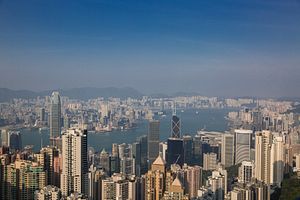The people of Hong Kong went to the polls on Sunday, September 4, 2016, to elect their Legislative Council representatives. This election period has been considered one of the most significant elections since the British handover of the territory back to China in 1997. Government data shows that the people are indeed much more invested in this year’s elections that they were in 2012 with overall turnout rate increasing from 43.85 percent to 52.57 percent in aggregate across all five geographic constituencies (more on constituencies below).
Although the system of government in Hong Kong has been accused of being toothless, as it does not directly participate in the introduction of laws, members of the Legislative Council play an important role in the functioning of the government and indirectly represent the voice of their voters. The Legislative Council scrutinizes bills presented by the Executive Council, and also plays a role in the control of public expenditure and the monitoring of the government’s performance.
The lead up to these elections was edgy to say the least. This is the first territory wide election since the Umbrella Movement of 2014, where more than 100,000 citizens, in protest against China’s sham universal suffrage electoral reforms proposal, occupied the main corridors of Hong Kong’s key business districts for several months. The protests eventually fizzled and protesters were forcibly removed from the streets.
However, the government was unable to sedate the political will of the Hong Kong masses. The chief executive tried to push the Beijing-sponsored electoral reform proposal bill through the legislative council. The first attempt was filibustered by pro-democracy parties. In the bills’ second reading, the pro-Beijing camp, without the numbers necessary to win the vote, attempted to out-maneuver the opposition by staging a walkout in order to reduce the number of members in the council and force an adjournment on the vote. However, due to a breakdown in communications, there were still enough members to form a quorum and the vote was held. The bill was voted down 28-8. The walk-out had failed, and was a major embarrassment for both the pro-Beijing representatives as well as the central government’s Liaison Office in Hong Kong.
The lack of any real change post-protests gave rise to a pro-democracy political movement, and somewhat of an awakening among the younger generation, which has traditionally been lackluster at best when it came to politics and voting. To the dismay of Beijing, a new generation of post-90s politicians have formed their own political parties, overwhelmingly in support of democracy and to a lesser extent independence. To counter this, the government has been accused of using the Electoral Affairs Commission to deny pro-independence parties the right to run for office, causing more negative publicity for the maligned incumbent Chief Executive.
Following the failed electoral reform bills in 2015 and the Executive Council’s refusal to consider alternatives, Hong Kong’s Legislative Council election process is still largely determined by the original rules set down in the Basic Law, with a few amendments since its ascension in 1997.
The Hong Kong Legislative Council is a representative system. Specifically, there are 70 members in each term of four years, determined by 35 Functional Constituencies and 35 members via direct elections by geographical constituencies.
Functional Constituencies were introduced during Hong Kong’s period as a British colony. These are professional or special interest groups that include the largest sector groups, as well as some concessionary parts of society — such as the social welfare constituency, as well as the rural sector, which represents indigenous rural villages. Significantly, the 30 Functional Constituencies gave voice to some of the traditionally dominant sectors of the economy, such as the medical, textiles and garment, and financial services sectors of the economy respectively. These constituencies are elected by the respective sector groups’ members only. While this may seem strange, it was a way to keep these core contributors to Hong Kong’s economy interested in Hong Kong. It has consequently ensured the power of the establishment, as most business sectors do not want to upset the Chinese government. In 2009, an additional five Functional Constituencies seats were introduced. Known as District Council (Second) constituencies, these members are directly elected by the people.
Hong Kong comprises five Geographical Constituencies: Hong Kong Island, Kowloon West, Kowloon East, New Territories West, and New Territories East. As the name suggests, these seats are elected by all eligible voters according to geographically divided constituencies. It is within these 35 proportional representative Geographical Constituency seats, and the five District Council (Second) constituency seats that the proxy battle is being waged between the pro-Beijing and pro-Democracy forces. Between the District Council (Second) constituencies and the Geographical Constituencies, a total of 40 out of 70 Legislative Council seats are directly electable by the majority of people.
In the final count, the pro-democrats won 19 of the 35 seats up for grabs in the Geographical Constituencies, plus three of the five District Council (Second) seats and another eight seats in the Functional Constituencies — more than enough seats for the opposition to hold on to its veto power. I’ll address the election results in more detail in my next piece.
































